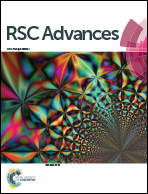Langmuir monolayer assisted formation of cadmium sulfide nanoparticles at the air–water interface and their role in the alignment of bulk liquid crystals
Abstract
Metal-sulfide nanoparticles can be fabricated by a one-step synthetic route by forming a Langmuir monolayer of long chain fatty acids over a subphase possessing metal ions and H2S gas in an air medium. Due to an interfacial reaction, the metal-sulfide nanoparticles are fabricated. The one-step synthesis can be further simplified by the appropriate choice of the amphiphilic molecules. The Langmuir monolayer of octadecanethiol (ODT) was reported to be stable over an ultrapure ion-free water subphase and can be perturbed significantly due to the presence of metal ions in the subphase. In this paper, we report the Langmuir monolayer assisted formation of CdS nanoparticles due to the interfacial interaction between the organosulfur compound, ODT and cadmium ions in the aqueous subphase. The films of nanoparticles were deposited on a hydrophilic quartz substrate by the Langmuir–Blodgett (LB) technique. UV-VIS spectra of the LB films of CdS nanoparticles at different target surface pressures and different Cd2+ ion concentrations depicted the signature of CdS nanoparticles. X-ray diffraction (XRD) measurements confirmed the crystalline structure of the CdS nanoparticles to be cubic. The average size of the CdS nanoparticles was estimated using field emission scanning electron microscopy, atomic force microscopy and XRD results and it was found to be in the range of 22–25 nm. We also incorporated CdS nanoparticles in the monolayer matrix of rod shaped liquid crystal (4-n-octyl-cyanobiphenyl, 8CB) molecules at an A/W interface, and transferred the film to solid substrates by the LB technique. Such LB films were employed as the alignment layer during the fabrication of liquid crystal cells and the alignment of bulk liquid crystal molecules in a nematic phase was studied using polarizing optical microscopy. The presence of CdS nanoparticles in the 8CB monolayer matrix reduces the surface anchoring of the liquid crystal molecule and thereby enhances the planar alignment of the bulk liquid crystal molecules.



 Please wait while we load your content...
Please wait while we load your content...